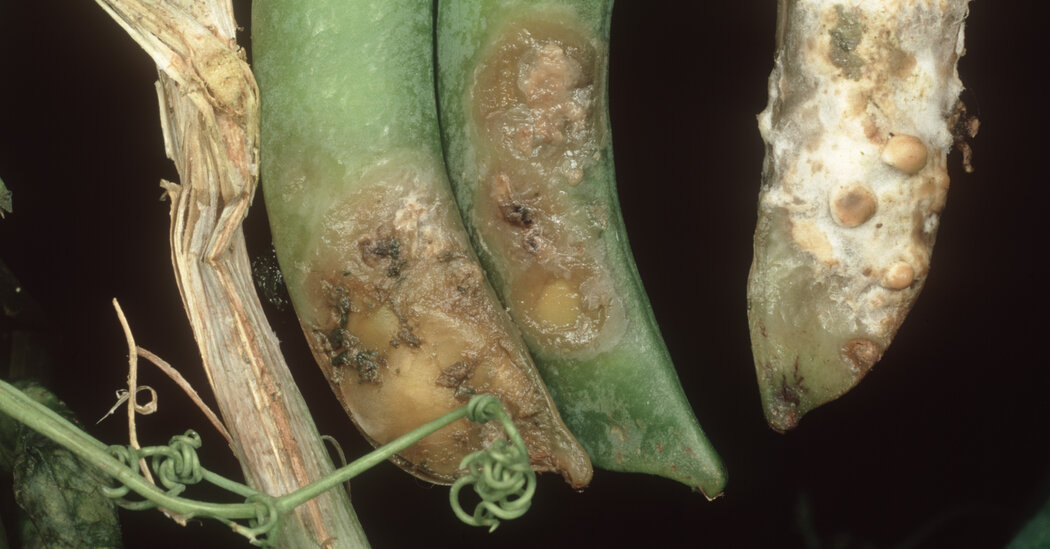When crops have nightmares, they dream of Sclerotinia sclerotiorum.
The fungus, known by stomach-turning names such as “white mold” and “watery soft rot,” manifests as a cottony, cream-colored fuzz that attaches to stems, where it gouges wound-like lesions. Tiny appendages called appressoria punch into cells with astounding force, while a torrent of toxins liquefies the plant’s innards, upon which the fungus begins to feast. Within days, the plant is dead.
“It really is a deadly fungus,” said Daohong Jiang, an agricultural microbiologist at Huazhong Agricultural University in Hubei, China.
Some 400 species of plants are thought to be susceptible to the pathogen, including soybeans, which fell in droves to the fungus in 2009, costing farmers $560 million. The fungus also goes dormant in soil for years, seeding new infections that can raze entire fields of crops.
Dr. Jiang has spent 10 years hot on Sclerotinia’s trail in the hopes of bringing the blight to heel. He and his colleagues now think they’ve found an answer: a treatment that doesn’t just stop the fungus from killing, but transforms it into a probiotic that can boost plant growth and enhance resilience to future disease. They reported their findings Tuesday in the journal Molecular Plant.
Their horticultural hero is a virus called SsHADV-1. Typically, it rides around on a fungus-munching insect called a mushroom fly. And it’s able to fully domesticate Sclerotinia over the course of a single encounter, turning a wolf into a watchdog.
“There have been some reports about how viruses are able to manipulate hosts, but this one is so unique,” said Aurelie Rakotondrafara, a plant pathologist at the University of Wisconsin, Madison, who was not involved in the study. “You can’t help but ask: How is this possible?”
Dr. Jiang’s team first noticed the virus’s unusual sway over Sclerotinia over a decade ago, when they discovered that rapeseed plants were able to peacefully coexist with virus-infected strains of the fungus, despite being felled in droves by their virus-free counterparts. What exactly drove the difference was, at the time, unclear.
Their latest work showed that the virus hijacked its host’s cells on a global scale, controlling which genes the fungus shut on and off as it infiltrated rapeseed plants. Virus-infected fungi, for instance, no longer flooded plants with tissue-macerating juices. And while they still forced their way into a host’s cells, the virus-infected fungi were far more gracious tenants, and left the rapeseed mostly intact.
The virus had, in effect, compelled the fungus into sheathing its plant-impairing weapons, Dr. Rakotondrafara said: “A mean pathogen turned into a gentle microbe.”
The puppeteering didn’t stop there. Bridled by the virus, Sclerotinia prompted the plants to sprout heftier leaves and more robust roots. The buoyed rapeseed plants also became resistant to virus-free Sclerotinia strains and other damaging fungi — a hint that the virus-infected fungus had acted as something of a crude “vaccine” against future disease, Dr. Jiang said.
What’s behind this bonus protective effect isn’t yet completely clear, said María Rebolleda Gómez, a microbial ecologist at Yale University who was not involved in the study. “Maybe it’s inside the cell and can outcompete other fungi that are trying to get in, or it is just priming the plant’s defenses,” she said.
Once tamed by the virus, the fungus also didn’t grow quite as enthusiastically on rapeseed, potentially because the newly bolstered plant was able to keep its guest in check, Dr. Jiang said. A fungus this docile, he added, could end up being a fantastic preventive treatment for vulnerable plants.
That’s something his team has already tried. Young plants sprayed with bits of virus-infected Sclerotinia matured alongside the domesticated fungus in the field, the researchers found, and wound up healthier than untreated plants.
Under natural circumstances, fungus-eating flies can chauffeur the virus from place to place. Dr. Jiang’s vision for crop protection would, in theory, be more direct: spiking fungus, pre-loaded with pacifying virus, onto plants. It would give farmers a speedy way to bolster their fields against future disease, he said, rather than being forced to scramble to contain an outbreak.
“Fungicides are working less and less all the time,” said Adriana Romero Olivares, a fungus expert at New Mexico State University who was not involved in the study. “This type of approach could be more sustainable,” she said, as long as the fungus doesn’t spontaneously jettison the virus and regain its plant-demolishing ways.
If the relationship between virus and fungus is as durable as it seems, it prompts fascinating questions about how the two microbes might coevolve, Dr. Romero Olivares said. Plenty of fungi are capable of playing nice with plants; some manage it after a past of crop-killing crime. What triggers that transition remains mysterious — but in at least some cases, viruses might be to blame, or, depending on your perspective, thank.
“We often think about microbes as, they’re pathogenic or not, bad or good,” Dr. Rebolleda Gómez said. “But the truth is, it depends quite a bit on the ecology and the interactions around it. This is a really cool example of that.”
Source: Read Full Article
